
In a QE first, an entire year group headed off to a West End theatre to watch a Shakespeare production.
 The 190 Year 9 boys saw Hollywood A-lister Sigourney Weaver starring in The Tempest at the Theatre Royal, Old Drury Lane.
The 190 Year 9 boys saw Hollywood A-lister Sigourney Weaver starring in The Tempest at the Theatre Royal, Old Drury Lane.
Their visit came shortly after QE’s Year 12 English Literature students took part in a two-day joint event with The Henrietta Barnett School that included a visit to a performance of Richard II at the Bridge Theatre in Bermondsey. QE has a long-standing partnership with the girls’ school, and this event was designed to stretch pupils of the two schools, giving them a taste of what studying Shakespeare at university might be like.
Head of English Robert Hyland said: “Giving students opportunities to experience live theatre remains a central part of our philosophy as an English department. In particular, given the density of language in Shakespeare’s plays, seeing them performed brings them to life in a way which the classroom simply cannot achieve.
“We were very lucky, therefore, to secure tickets to see two sell-out shows in The Tempest and Richard II. Taking just under 200 Year 9 students to see The Tempest will remain a highlight of the academic year. For many, it will have been their first experience of professional theatre, and one which I hope will last for many years after they leave the School. Even afterwards, I could still hear students around the School and in class discussing features of the performance, which hopefully balanced enjoyment with a richer and deeper understanding of the text.
 “Working with our colleagues at Henrietta Barnett allowed us to put on a brilliant day and a half of activities. From a standing start, students became fully acquainted with the characters and themes of the under-appreciated Richard II. It was a treat to see students fully engaging in the dramatic activities, and speaking so knowledgeably about the Bridge Theatre performance.”
“Working with our colleagues at Henrietta Barnett allowed us to put on a brilliant day and a half of activities. From a standing start, students became fully acquainted with the characters and themes of the under-appreciated Richard II. It was a treat to see students fully engaging in the dramatic activities, and speaking so knowledgeably about the Bridge Theatre performance.”
The Year 9 boys students studied The Tempest in the Autumn Term, with the trip therefore forming a conclusion to their studies. Sigourney Weaver, the star of films including Alien and Avatar, played Prospero in a Jamie Lloyd Theatre company production. It was, said Mr Hyland, “a rare opportunity for students to see a world-class actor and production company in real life”. Fourteen staff, drawn from all departments, accompanied the pupils.
Asked to write their own reviews, the Year 9 boys were enthusiastic about their visit. Ridit Bhor praised the “wonderful chemistry” shared by the characters, Miranda and Ferdinand, while others praised the set design, described by Pothan Bobba as “nothing short of spectacular” and by Avi Aggarwal as “hauntingly beautiful”.
 The two-day Sixth Form event centred around the production of Richard II at the Bridge Theatre production, which starred Jonathan Bailey, of Bridgerton and Wicked fame. In addition to seeing the production, the event involved:
The two-day Sixth Form event centred around the production of Richard II at the Bridge Theatre production, which starred Jonathan Bailey, of Bridgerton and Wicked fame. In addition to seeing the production, the event involved:
- An introductory lecture on the play from Dr Diana Hallam, A-level specialist and founder of Literary Lectures, which explored the contextual significance of the play;
- A drama workshop from Mandy Dassa (from QE’s drama partners, RM Drama), exploring the play from a practical perspective;
- Seminars exploring key scenes and speeches from the text, led by Mr Hyland and teachers from the girls’ school;
- A tour of the Globe Theatre combined with a drama workshop on Richard II, led by Royal Shakespeare Company and Globe Theatre actor Chu Omambala.
“We wanted to take students away from their exam specification, and help them understand what it might be like to study Shakespeare at a higher level and through different methods than the A-level allows,” said Mr Hyland. “By picking a text they were unfamiliar with, and allowing them to explore it beyond the normal classroom setting, students were able to develop their skills of interpretation and analysis. And by pairing up with our colleagues at HBS, they could also work with new faces, gaining new ideas and original perspectives.
“With the range of activities on offer, from university-style lectures, seminars, drama, and fieldwork, this partnership event really did give a sense of how exciting and varied studying English at a higher level can be.”


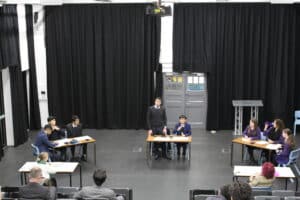 The studio, created from two existing large rooms towards the rear of the Main Building, hosted early rounds of the English Speaking Union’s Schools’ Mace debating contest and of the national Performing Shakespeare competition.
The studio, created from two existing large rooms towards the rear of the Main Building, hosted early rounds of the English Speaking Union’s Schools’ Mace debating contest and of the national Performing Shakespeare competition.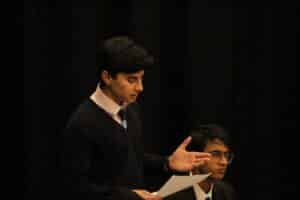 At the Mace, the country’s oldest and largest debating competition for schools, a senior QE team – including School Captain Chanakya Seetharam, as well as Zaki Mustafa, and Koustuv Bhowmick, all from Year 13 – took on Haberdashers’ Girls’ School. Other leading schools from North London and Hertfordshire also competed. The QE team won the event to progress to the second-round heats in January.
At the Mace, the country’s oldest and largest debating competition for schools, a senior QE team – including School Captain Chanakya Seetharam, as well as Zaki Mustafa, and Koustuv Bhowmick, all from Year 13 – took on Haberdashers’ Girls’ School. Other leading schools from North London and Hertfordshire also competed. The QE team won the event to progress to the second-round heats in January. 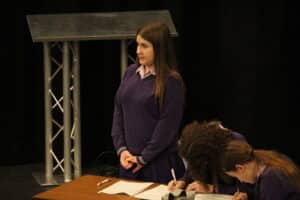 Head of English Robert Hyland said: “There are some things which reading Shakespeare simply as words on the page can never give – so much of the impact of his work comes from how performers have chosen to interpret, following the rhythms and the imagery of the poetry to bring the words to life.
Head of English Robert Hyland said: “There are some things which reading Shakespeare simply as words on the page can never give – so much of the impact of his work comes from how performers have chosen to interpret, following the rhythms and the imagery of the poetry to bring the words to life.  The special English lesson held in RDS also focused on Shakespeare, looking at scene 3 from act 3 of
The special English lesson held in RDS also focused on Shakespeare, looking at scene 3 from act 3 of 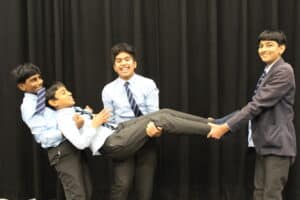 “We subsequently returned to the language, thinking about the delivery of the speech which Ariel gives, and what key or words ideas come to light when presented dramatically.”
“We subsequently returned to the language, thinking about the delivery of the speech which Ariel gives, and what key or words ideas come to light when presented dramatically.” 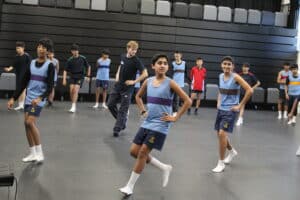 ENB dancers and a musician later came to QE and gave the boys a two-hour contemporary ballet workshop, testing the RDS’s audio equipment to the full. They explored ways of moving, inspired by the plot, characters and choreography of
ENB dancers and a musician later came to QE and gave the boys a two-hour contemporary ballet workshop, testing the RDS’s audio equipment to the full. They explored ways of moving, inspired by the plot, characters and choreography of 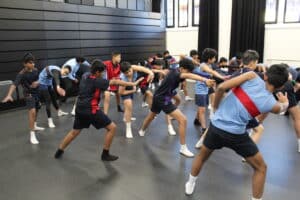 “Best of all though was the enthusiasm and energy the boys put into their dancing. Who knows – maybe the next Akram Khan has just learnt his first dance steps?
“Best of all though was the enthusiasm and energy the boys put into their dancing. Who knows – maybe the next Akram Khan has just learnt his first dance steps?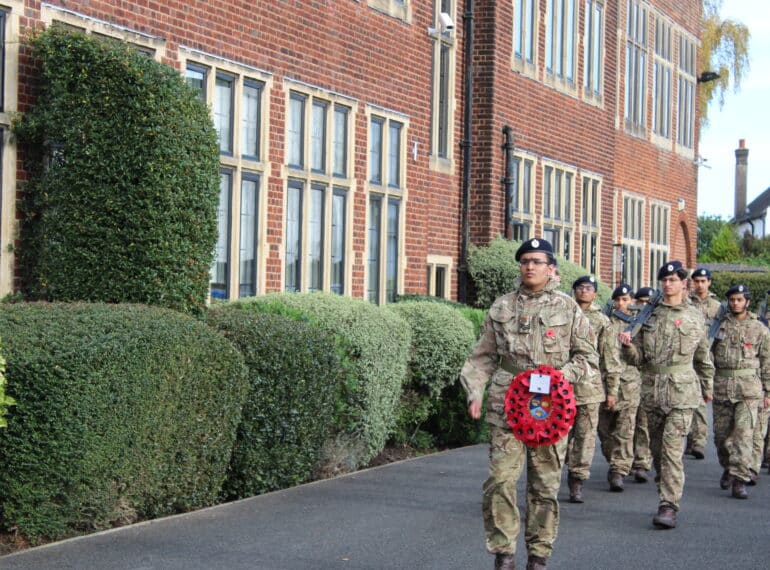

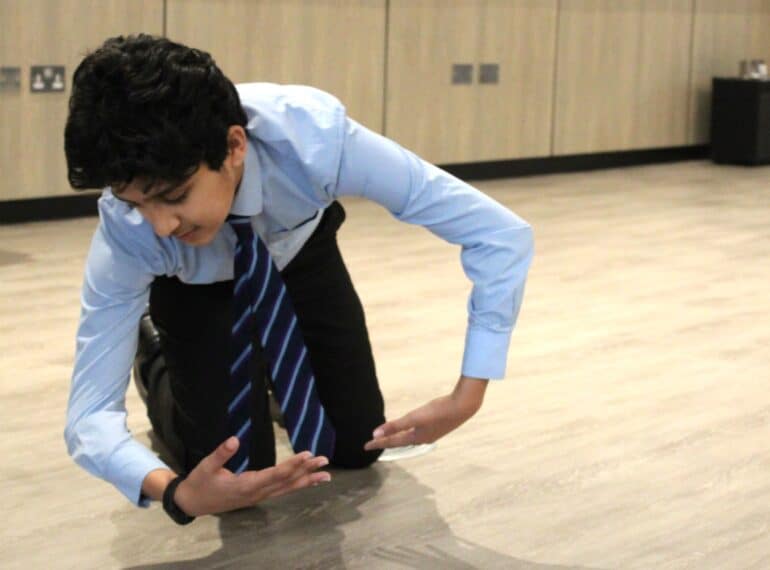
 Vihaan, pictured here and top, delivered the speech from Romeo and Juliet given by Romeo as he lay dying – giving a repeat of his performance in School, which was praised for its maturity and sensitivity.
Vihaan, pictured here and top, delivered the speech from Romeo and Juliet given by Romeo as he lay dying – giving a repeat of his performance in School, which was praised for its maturity and sensitivity. “We were therefore delighted to host two rounds of the competition. Although Vihaan did not progress through the regional final, he did very well to make it through the semi-finals and is to be congratulated on a series of accomplished performances.
“We were therefore delighted to host two rounds of the competition. Although Vihaan did not progress through the regional final, he did very well to make it through the semi-finals and is to be congratulated on a series of accomplished performances. The boys were judged not only on their physical performance and their vocalisation, but on how far their performance suited the speech, and how far their interpretation of the speech met their artistic intention.
The boys were judged not only on their physical performance and their vocalisation, but on how far their performance suited the speech, and how far their interpretation of the speech met their artistic intention. Ms Shah praised the work that the QE boys put into their performances. “I was amazed by the vulnerability of some of these speeches and the maturity and sensitivity with which they were delivered. These qualities were particularly obvious in the speech of our winner Vihaan, who chose Romeo’s last speech to Juliet. He conjured Juliet’s body out of thin air with his delivery of Shakespeare’s words, and his choice of a vulnerable speech was a brave one.”
Ms Shah praised the work that the QE boys put into their performances. “I was amazed by the vulnerability of some of these speeches and the maturity and sensitivity with which they were delivered. These qualities were particularly obvious in the speech of our winner Vihaan, who chose Romeo’s last speech to Juliet. He conjured Juliet’s body out of thin air with his delivery of Shakespeare’s words, and his choice of a vulnerable speech was a brave one.”
 Suryansh Sarangi was selected as one of nine overall winners – and one of only two from outside the US – after penning a review that commented not only on the clothes, but on the collection’s relationship to the American dream.
Suryansh Sarangi was selected as one of nine overall winners – and one of only two from outside the US – after penning a review that commented not only on the clothes, but on the collection’s relationship to the American dream. The city, he noted, carried special significance for Balenciaga’s creative director, Demna Gvasalia: “Having grown up in a dreary ‘post-Soviet vacuum’, Demna himself states that the very culture he idolized as the perfect, colorful life was that of L.A.”
The city, he noted, carried special significance for Balenciaga’s creative director, Demna Gvasalia: “Having grown up in a dreary ‘post-Soviet vacuum’, Demna himself states that the very culture he idolized as the perfect, colorful life was that of L.A.” “I did not have to research much; I just had to watch the fashion show on YouTube, and from there, it was just about interpreting it and analysing it beyond its face value.
“I did not have to research much; I just had to watch the fashion show on YouTube, and from there, it was just about interpreting it and analysing it beyond its face value.